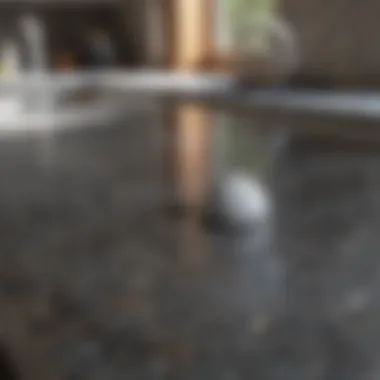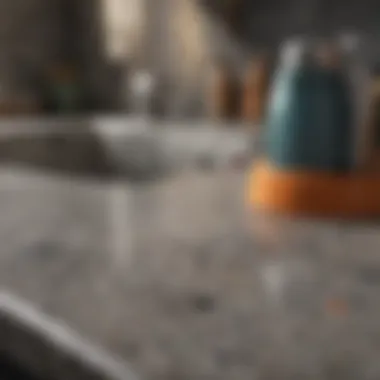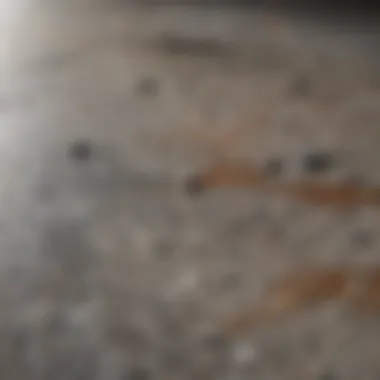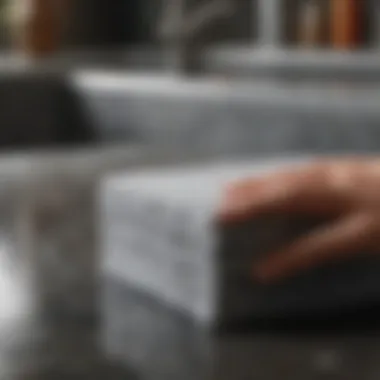Effective Strategies for Cleaning Granite Surfaces


Intro
Granite surfaces have gained significant popularity in homes due to their durability and aesthetic appeal. They can elevate the look of kitchens, bathrooms, and countertops. However, maintaining the pristine condition of granite requires a deeper understanding of effective cleaning strategies.
In this guide, we will explore methods for cleaning granite, both in everyday use and when addressing stubborn stains. Using the right products and techniques will ensure your surfaces remain beautiful over time. This article will delve into cleaning agents, upkeep routines, and practical tips tailored for homeowners and interior design enthusiasts.
Design Inspirations
Trending Styles
Granite surfaces can complement various design styles. Modern kitchens often use sleek granite slabs that create clean lines. In contrast, rustic spaces may embrace textured granite with natural finishes. The versatility of granite allows it to adapt to current trends, whether in a contemporary or vintage setting.
Color Palettes
The color of your granite can impact your overall interior design. Lighter shades such as white and cream can make spaces appear larger and more open. Darker hues, including deep blue or black, offer a dramatic flair, adding depth and sophistication. Selecting the right shade enhances the granites aesthetic, reinforcing the room's atmosphere while providing a functional surface.
Maintenance and Upkeep
Seasonal Maintenance Checklist
Regular maintenance is crucial for preserving the quality of granite. This checklist ensures that you keep your surfaces in top condition:
- Inspect for Chips or Cracks: Address any damage immediately to prevent further issues.
- Reseal Granite Surfaces: Depending on usage, reseal every 6-12 months to maintain resistance to stains.
- Check Caulking: Ensure sealants around sinks and backsplashes are intact.
- Clean Regularly: Develop a routine cleaning schedule to prevent dirt buildup.
Cleaning and Organization Tips
Proper cleaning methods can significantly extend the life of your granite surfaces. Follow these tips:
- Use a Soft Cloth or Sponge: Avoid abrasive materials that can scratch the stone.
- Utilize Mild Soap: A mixture of warm water and a few drops of dish soap is effective. Always rinse with clean water afterward.
- Avoid Harsh Chemicals: Products with vinegar or lemon can etch the surface.
"Keeping granite surfaces clean and well-maintained not only preserves their beauty but also enhances the durability of the stone over time."
Implement these strategies to ensure your granite surfaces maintain their integrity and appeal. The right approach to cleaning can make a substantial difference, preserving the beauty and utility of once considered mere stone.
Foreword to Granite Cleaning
Granite surfaces, prized for their beauty and durability, require deliberate care to maintain their luster. Understanding the methods and tools available for cleaning granite is essential for homeowners and design enthusiasts alike. This section emphasizes the significance of proper cleaning techniques, focusing on how they can preserve the stone's integrity and appearance. In doing so, one not only enhances the visual appeal of granite but also extends its lifespan, making it a valuable investment in any home.
Understanding Granite as a Material
Granite is an igneous rock composed of quartz, feldspar, and mica. Its formation takes place deep within the Earth’s crust under extreme heat and pressure. This process results in a dense and resilient material, well-suited for countertops, flooring, and other uses in interior design.
This resilience is a benefit; however, it also requires mindful cleaning practices. Granite is porous, meaning that it can absorb spills, leading to potential staining if not properly maintained. Understanding these characteristics is crucial for anyone responsible for caring for granite surfaces.
The Significance of Proper Cleaning Methods
Proper cleaning methods hold great importance in maintaining the aesthetic and functional qualities of granite. A failure to follow effective strategies can lead to damage, blemishes, and a decline in the material’s overall appearance. Key considerations include:
- Avoiding Harsh Chemicals: Some cleaning agents can be abrasive or acidic, which may etch or discolor the granite surface over time.
- Frequency of Cleaning: Regular cleaning can prevent dirt and grime buildup, making it easier to maintain the stone.
- Utilizing Appropriate Tools: Using the correct tools, such as soft cloths and gentle brushes, is critical to prevent scratching the surface.
Adopting these methods ensures that granite surfaces remain stunning and serviceable for years to come.
"Investing time in understanding granite's properties significantly benefits its upkeep and longevity."


Choosing Cleaning Solutions
Choosing the right cleaning solutions for granite surfaces is a critical component of granite maintenance. The durability and visual appeal of granite depend significantly on the cleaning methods and products used. An inadequate cleaner can damage the surface, resulting in dullness or stains, ruining its natural beauty. Therefore, understanding the available options is key.
In this section, we explore both natural and commercial cleaning solutions. Each alternative presents its own benefits and considerations, making it essential for the user to evaluate what aligns best with their needs and circumstances.
Natural Cleaning Agents
Natural cleaning agents are often seen as safer alternatives to commercial products. They are usually less harmful to the environment and can be made from common household items. Here are three popular natural agents:
Vinegar and Water Solution
Vinegar and water solution is a straightforward yet effective cleaner. The acetic acid in vinegar can break down dirt and grime without being overly harsh. This solution is a cost-effective choice that many homeowners prefer. However, it’s important to note that vinegar is acidic. Using it too frequently can degrade the finish of granite over time. Therefore, it must be diluted and used sparingly.
Baking Soda Paste
Baking soda paste is another excellent choice for cleaning granite. When mixed with water to a paste-like consistency, it provides a gentle abrasive that can lift stains without scratching the surface. The unique feature of baking soda is its ability to neutralize odors and absorb moisture. While it’s beneficial for removing tough spots, users should ensure it’s rinsed off thoroughly, as a residue may develop if left too long.
Essential Oils
Essential oils, like lemon or tea tree, can also aid in cleaning granite while imparting a pleasant scent. These oils have natural antibacterial properties, making them useful for cleaning surfaces that often interact with food. However, their effectiveness can vary by type and concentration. They should complement other cleaning methods rather than serve as a sole solution.
Commercial Cleaning Products
For those who prefer ready-made solutions, commercial cleaning products provide a wide range of options designed specifically for granite surfaces. These products usually come with clear usage instructions and are formulated for optimal results. Below are three types of popular commercial cleaners:
pH-Neutral Cleaners
pH-neutral cleaners are specially designed to clean sensitive surfaces without altering their chemical balance. This behavior ensures that granite's shine remains intact. The key characteristic of these cleaners is their gentle formula, which avoids harsh chemicals that may etch the stone. They are particularly beneficial for routine cleaning, making them a staple in many households.
Stone-Specific Cleaners
Stone-specific cleaners are developed with special ingredients tailored for the needs of granite and similar materials. Their formulas help maintain the stone's luster while effectively removing tough stains. The main advantage here is that users can trust these products to be safe and effective on granite surfaces. However, it is essential to follow the manufacturer’s instructions to maximize effectiveness and avoid damaging the material.
Multi-Surface Cleaners
Multi-surface cleaners provide versatility, allowing users to clean various surfaces all in one go. These products save time and space, appealing to homeowners who appreciate convenience. However, it’s crucial to ensure that the cleaner is compatible with granite. Some multi-surface cleaners contain ingredients that might harm the stone. Always check the label before use and consider separate products for granite maintenance.
Choosing the right cleaning solution for granite involves balancing effectiveness with safety. Whether utilizing natural agents or commercial products, understanding their features can significantly enhance cleaning outcomes.
Essential Cleaning Tools
In maintaining granite surfaces, it is vital to utilize the right cleaning tools. The selection of cleaning tools can significantly influence both the effectiveness of the cleaning process and the preservation of the granite's integrity. Using appropriate tools can help avoid scratches and damage while ensuring thorough cleaning. This section explores essential tools that can make a substantial difference in the upkeep of granite.
Microfiber Cloths
Microfiber cloths are among the top tools for cleaning granite surfaces. They possess a unique structure that makes them highly effective in trapping dust and grime. Unlike traditional cleaning fabrics, microfiber is non-abrasive, which means it can effectively clean the surface without scratching it. This quality is crucial when caring for delicate surfaces like granite.
Additionally, microfiber cloths are versatile. They can be used wet or dry. When dampened, they easily lift stains and spills without the need for harsh chemical agents. Simply adding a splash of water will enhance their cleaning capability. Regular cleaning with microfiber cloths promotes a shine that maintains the beauty of granite surfaces.
Soft-Bristled Brushes
For more challenging stains or dirt that requires a bit more agitation, soft-bristled brushes are essential. They allow homeowners to scrub areas that may have built-up residue without risking damage to the granite. The softness of the bristles ensures that the surface remains intact while removing stubborn spots.
When using soft-bristled brushes, it is advisable to choose a brush with synthetic bristles specifically designed for delicate surfaces. These brushes are effective without being too harsh, making them a safe option for regular maintenance. They can also reach crevices and corners, ensuring a more thorough clean, which is particularly important in high-use areas like kitchens or bathrooms.


Non-Abrasive Sponges
Non-abrasive sponges are another critical tool in the granite cleaning arsenal. These sponges provide a balance between effective cleaning and surface safety. Similar to the microfiber cloths, non-abrasive sponges do not scratch the surface, making them suitable for everyday cleaning tasks.
When selecting a sponge, look for one labeled specifically for use on stone surfaces. They come in various shapes and sizes, which make it easy to tackle both large surfaces and detailed areas. Used in conjunction with appropriate cleaning solutions, non-abrasive sponges can help in maintaining the finish of granite while ensuring the removal of grime and stains.
Proper cleaning tools are indispensable to maintain the aesthetics and durability of granite surfaces. Investing in the right tools can save time and prevent damage in the long run.
By incorporating microfiber cloths, soft-bristled brushes, and non-abrasive sponges into your cleaning routine, you can assure effective and safe maintenance of your granite surfaces. Each tool plays a specific role but collectively helps preserve the natural beauty of granite, extending its lifespan in your home.
Cleaning Techniques
Cleaning granite surfaces properly is essential for maintaining their beauty and durability. This section explores the various techniques that homeowners and enthusiasts can employ to keep their granite looking its best. By understanding effective cleaning methods, one can prevent damage and preserve the stone's natural appeal. Proper techniques not only enhance aesthetics but also contribute to the longevity of granite surfaces.
Basic Cleaning Steps
To maintain granite surfaces, regular and straightforward cleaning is vital. Here are the fundamental steps to follow:
- Gather Supplies: You will need a pH-neutral cleaner, warm water, a microfiber cloth, and possibly a soft-bristled brush for tough spots.
- Prepare the Cleaning Solution: Mix the pH-neutral cleaner with warm water according to the instructions on the product label.
- Apply the Solution: Dampen the microfiber cloth in the cleaning solution. Wipe down the granite surface, making sure to remove any dirt or grime.
- Rinse: After cleaning, rinse the cloth and wipe the surface again with clean water. This helps to remove any remaining soap or cleaner residue.
- Dry: Finally, dry the granite with a clean, dry microfiber cloth to prevent water spots.
These simple steps help maintain the surface without causing any damage.
Deep Cleaning Methods
Occasionally, granite surfaces require more thorough cleaning to deal with stubborn stains or a build-up of grime. Deep cleaning methods involve:
- Identifying the Type of Stain: Oil, grime, or food spills require different approaches. Knowing what you are dealing with enables you to select the right cleaning method.
- Using a Poultice: For oil stains, create a poultice with baking soda and water to form a paste. Apply it to the stain, cover it with plastic wrap, and leave it for 24 hours. This method draws the oil out of the stone.
- Disinfecting with Rubbing Alcohol: For thorough cleaning, a solution of 70% rubbing alcohol and water can be effective. Apply it to a cloth and wipe the surface, especially in areas that experience higher foot traffic.
By incorporating these deep cleaning methods occasionally, homeowners can effectively combat tougher stains that regular cleaning cannot eliminate.
Drying and Polishing
After cleaning, drying and polishing the surface is crucial to enhance its appearance. Here’s how to proceed:
- Immediate Drying: Always dry your granite surface after cleaning. Use a separate clean microfiber cloth for drying to ensure no dirt is left behind.
- Polishing Solution: For added shine, consider using a granite-specific polish. It provides a protective layer while enhancing the stone’s color.
- Application: Follow the product instructions. Usually, it involves spraying a small amount on the surface and buffing with a clean cloth.
- Regular Care: Regular polishing can keep your granite looking new and vibrant, making it an essential part of granite maintenance.
Regular cleaning and proper drying techniques extend the life of granite surfaces, ensuring they serve both functionally and aesthetically for years to come.
By understanding the importance of these cleaning techniques, granite surface care can be efficient and effective. Simple practices yield great results while preserving the integrity of the stone.
Addressing Stains and Marks
Understanding how to address stains and marks on granite surfaces is crucial for maintaining the stone’s elegance and longevity. Granite, while durable, can become marred by various substances found in everyday life. Effectively treating these stains not only restores the surface's appearance but also preserves its integrity. Ignoring stains can lead to more severe damage, which may require costly repairs or replacements. Thus, knowledge of common stains and their respective solutions is essential for anyone looking to keep granite surfaces looking pristine.
Common Stains and Their Solutions
Oil Stains
Oil stains are a frequent issue that homeowners encounter on granite surfaces, especially in kitchens. These stains occur from cooking oils, greasy substances or cosmetics that can seep into the stone. The key characteristic of oil stains is their ability to penetrate the granite, making them particularly challenging to remove. This aspect is significant because if not addressed promptly, oil stains can become permanent and affect the stone's aesthetic value.
To combat oil stains, a poultice made from baking soda and water can be applied. This mixture draws the oil out of the granite while not damaging the surface. However, the downside is that this method can take time to work, often requiring several applications over a few days.
Water Marks
Water marks can appear from moisture pooling on granite surfaces, especially if the stone is not properly sealed. These stains manifest as dull spots or rings. The key characteristic of water marks is their formation through mineral deposits left behind after evaporation. Recognizing this trait is vital as it signifies that the granite may need sealing or a deep clean.


Using a mixture of mild detergent and water often helps in removing these marks. However, if the marks persist, commercial cleaners specifically designed for granite might be necessary. One downside of water marks is that they can indicate improper care. Hence, it is critical to regularly maintain granite surfaces to prevent their occurrence.
Food Spills
Food spills represent another common source of stains on granite countertops. Items like sauces, wine, and fruits can leave unsightly marks if not cleaned quickly. The key characteristic of these stains is their variety, since different foods contain various pigments and acids. This diversity makes food spills a popular topic when discussing granite care because they are often unavoidable in daily life.
For cleaning, wiping spills immediately with a damp cloth is effective. However, stubborn stains may require using a specialized stone cleaner. The advantage of addressing food spills swiftly is that it often prevents the stain from setting in, leading to better overall maintenance of the granite surface.
Using Poultices for Stain Removal
Poultices are an effective method for removing tough stains from granite. They involve the application of a paste that draws out impurities from the stone. Using a poultice typically involves mixing an absorbent material, such as baking soda or flour, with a liquid, often water or a cleaning solution. This paste is spread over the stain, covered with plastic wrap, and left to sit for 24-48 hours. After that, the poultice absorbs the stain, making it easier to wipe away any residue.
While poultices are effective, they require patience and may not produce immediate results. However, they remain one of the best strategies for deep stain removal, ensuring that granite surfaces are well-maintained. A well-crafted poultice not only tackles the current issue but also highlights the overall importance of proactive care for granite surfaces.
Maintaining granite surfaces is not just about cleaning; it's about proactive strategies that ensure beauty and resilience over time.
Preventive Care for Granite
Cleaning granite surfaces effectively requires a strong foundation of preventive care. This aspects are often overlooked, yet they are essential in preserving the longevity and appearance of granite. Regular preventive measures can greatly reduce the risk of damage and staining. With proper care, granite remains a beautiful addition to any home, reflecting elegance and durability.
Regular Maintenance Schedule
Implementing a regular maintenance schedule is crucial. Homeowners should assess their granite surfaces often, determining how frequently they need cleaning. Recommended frequency typically depends on usage. For instance:
- Kitchens: Daily wipe-downs are advised due to food spills and stains.
- Bathrooms: Weekly cleanings are often sufficient, with more attention after heavy use.
- Other Types of Spaces: Monthly maintenance may suffice for living areas or less trafficked rooms.
During regular cleanings, use a pH-neutral cleaner specifically made for stone surfaces. Avoid harsh chemicals, as these may strip the granite of its protective layer. After cleaning, dry with a soft cloth to prevent water spots.
Taking the time to maintain granite surfaces daily not only enhances their appearance but also prolongs their lifespan.
Sealing Granite Surfaces
Sealing granite is another preventive strategy that should not be ignored. A good-quality sealant acts as a barrier against moisture and stains. Sealing preserves the stone’s natural beauty and prevents damage from spills.
Granite should generally be resealed every one to two years. However, the actual frequency depends on the absorption rates of the specific granite type. To check if sealing is necessary, sprinkle a few drops of water on the surface. If the water beads up, sealing is still effective. If it soaks in, it is time to reseal.
When sealing:
- Choose the Right Sealant: Opt for a product specifically designed for granite.
- Apply Evenly: Use a clean cloth or foam brush to apply the sealant in a uniform manner.
- Follow Manufacturer Instructions: Adhere to recommended drying times and application methods for optimal results.
Sealing minimizes upkeep efforts and enhances the stone’s resistance to stains, ensuring a lasting shine.
By incorporating these preventive care strategies into regular home maintenance routines, granite surfaces will stay attractive and functional for years.
The End and Best Practices
Effective cleaning of granite surfaces is crucial not only for aesthetic appeal but also for preserving the integrity and longevity of the material. The right methods and products can ensure that granite retains its natural beauty while resisting damage from everyday use. Proper care contributes to maintaining property value and offers lasting satisfaction for homeowners.
Following comprehensive cleaning strategies enhances the overall experience of living with granite. Understanding both natural and commercial cleaning solutions allows individuals to select the best approach for their specific needs. It also encourages a balanced perspective between eco-friendly practices and the effectiveness of specialized products.
Summary of Key Points
- Granite Composition: Understanding granite's porous nature is vital. It can retain stains and spills if not properly maintained.
- Cleaning Solutions: Knowledge of effective natural alternatives like vinegar and baking soda, combined with the appropriate commercial cleaners, can offer versatility in tackling different cleaning challenges.
- Essential Tools: Utilizing the right tools, such as microfiber cloths and non-abrasive sponges, enhances cleaning effectiveness and protects the stone.
- Cleaning Techniques: Familiarity with both basic and deep cleaning techniques ensures all levels of dirt and grime are efficiently managed.
- Stain Management: Being proactive about common stains and knowing how to use poultices effectively is key to long-term granite care.
- Preventive Measures: Regular maintenance and sealing granite surfaces can significantly extend the life of the stone.
This comprehensive knowledge arms homeowners with the insight needed to handle their granite surfaces with competence and care.
Final Recommendations
- Adopt a Routine: Create a regular cleaning schedule that includes both daily cleaning and deeper maintenance intervals, ensuring that your granite surfaces remain in prime condition.
- Choose Quality Products: Always select high-quality, pH-neutral cleaners designed specifically for granite. Avoid acidic or abrasive products that can damage the stone.
- Seal Regularly: It is essential to seal granite surfaces periodically, typically every six months to a year, depending on usage. This can prevent stains and enhance durability.
- Act Quickly on Spills: Attend to spills immediately to avoid potential staining. Using a clean, dry cloth to absorb spills can minimize damage.
- Educate Others: Ensure that family members and household staff are aware of the best practices for granite care to create a cohesive cleaning approach.
Incorporating these best practices will not only simplify the cleaning process but also sustain your granite surfaces for years to come.







